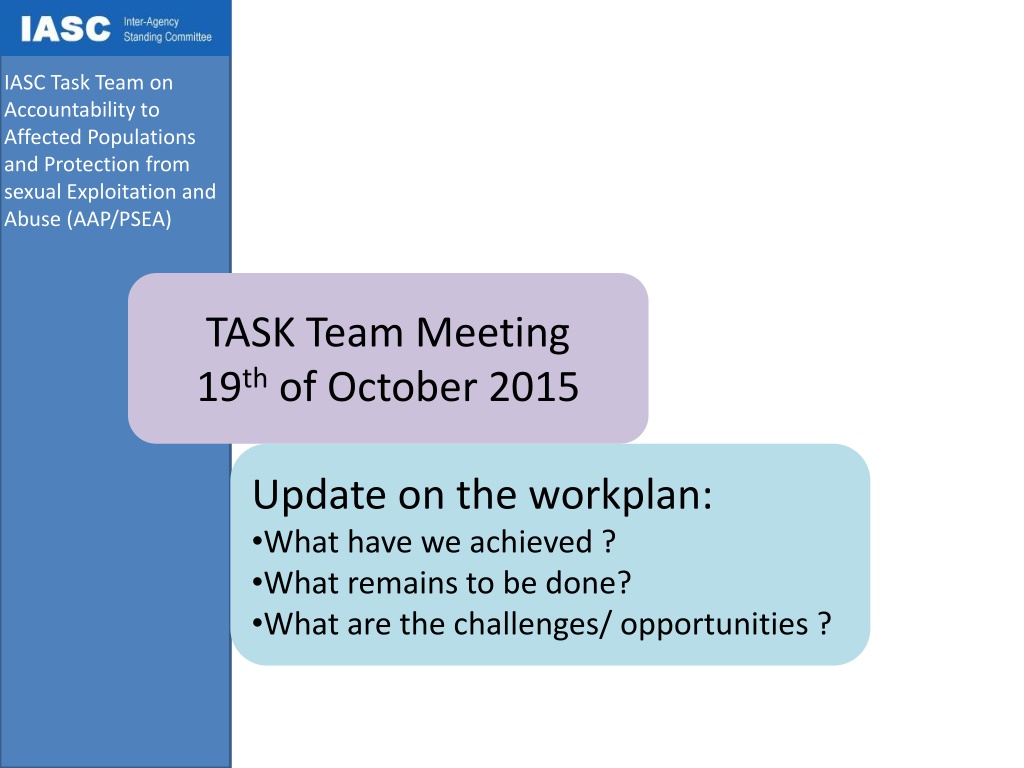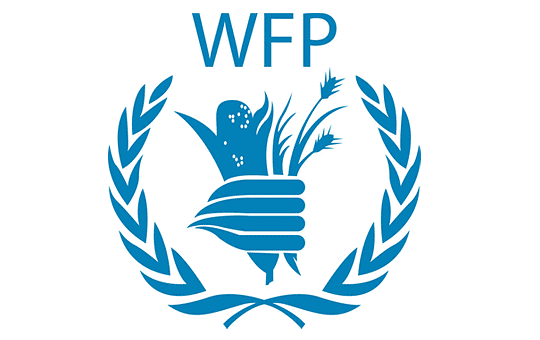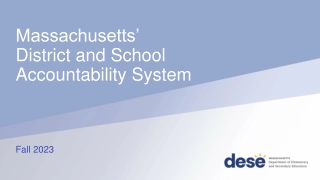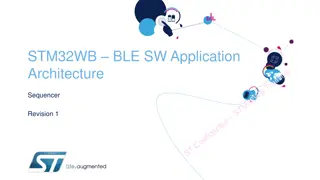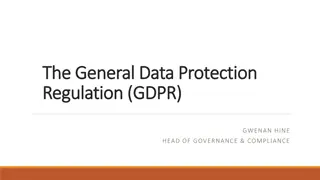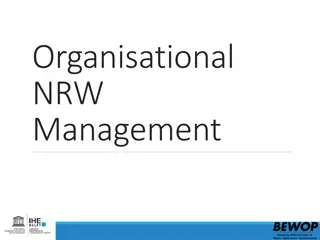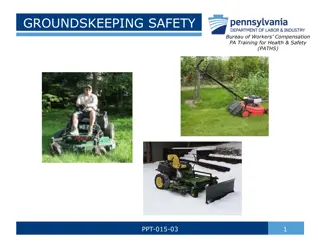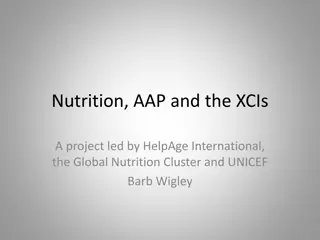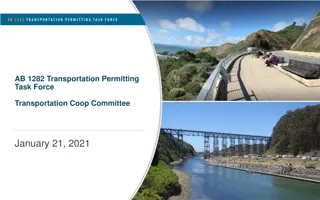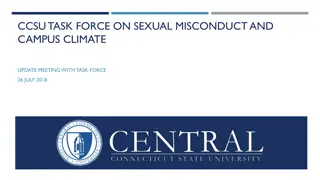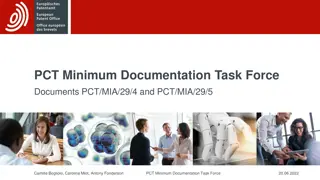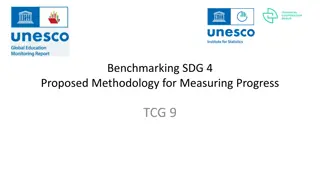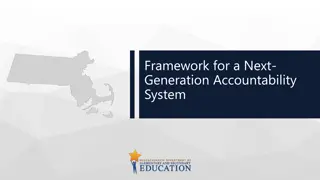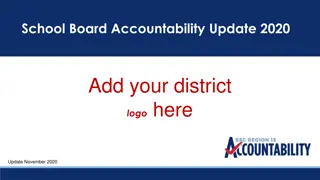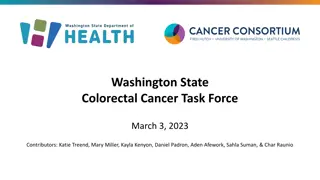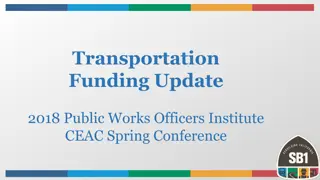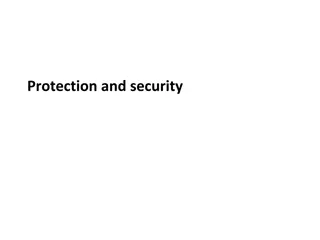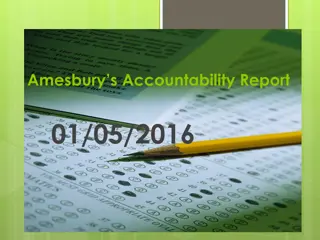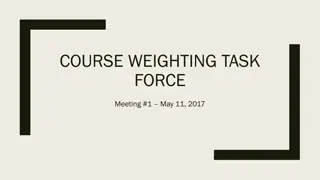Accountability and Protection Task Team Progress Update
The IASC Task Team on Accountability to Affected Populations and Protection from Sexual Exploitation and Abuse (AAP/PSEA) provided an update on their workplan achievements, remaining tasks, challenges, and opportunities. Progress includes establishing a common language for AAP and PSEA, advocating for AAP/PSEA in the World Humanitarian Summit, and supporting field operations in various countries like Lebanon, DRC, Ukraine, and Iraq.
Download Presentation

Please find below an Image/Link to download the presentation.
The content on the website is provided AS IS for your information and personal use only. It may not be sold, licensed, or shared on other websites without obtaining consent from the author. Download presentation by click this link. If you encounter any issues during the download, it is possible that the publisher has removed the file from their server.
E N D
Presentation Transcript
IASC Task Team on Accountability to Affected Populations and Protection from sexual Exploitation and Abuse (AAP/PSEA) TASK Team Meeting 19th of October 2015 Update on the workplan: What have we achieved ? What remains to be done? What are the challenges/ opportunities ?
Establishing a common language for AAP and PSEA among organizations Objective 1.1 Language Merger Done to date? Two pager summarizing the essential linkages between AAP and PSEA and included in the Helpdesk resources Key messages sent to highlight the linkages between AAP and PSEA during the Senior Focal Point meeting on PSEA 16 April 2015 The essential linkages between AAP and PSEA have been highlighted in messages to Task team members, during webinars (STAIT webinars in English and French, Interaction webinar) and in training modules being developed by Disasterready.org. Essential linkages highlighted during field missions in Eastern DRC/ Ukraine etc Work Stream 1 AAP/PSEA Advocacy Continuous efforts to ensure members highlight the essential linkages between AAP and PSEA during field missions, advocacy and training. Lead Still to be done? Importance to insist on AAP and PSEA as right- based approaches Contact: Rebecca Skovbye
AAP and PSEA in the World Humanitarian Summit AAP emerging as a priority in the WHS consultations Paper on CAAP has been sent to the WHS secretariat WFP is a member of the effectiveness team of the summit secretariat , and pushing for AAP Participation of Task Team co-chair to the WHS meeting on 4-5 June in NY convened by ALNAP and organized with USAID, OIC and the WHS secretariat, ensuring key messages and comments from Task team members on the different papers are shared during the forum Objective 1.2 World Humanitarian Summit Done to date? Work Stream 1 AAP/PSEA Advocacy Support to ensuring that the recommendations with regards to AAP PSEA are actually corresponding to what communities would need. The WHS might have additional funding to support further community consultations and the task team could provide the operational support Still to be done? Lead Contact: Rebecca Skovbye
Field missions and in-country support+ feedback and lessons learning Objective 2.1 Support to AAP and PSEA field operations Lebanon: AAP reinforced in the Lebanon Crisis Response Plan, additional support needed for some areas of the action plan, specific support requested on PSEA DRC: Following the workshop on AAP and PSEA, full PSEA training by the CBCM team to the RRMP took place mid Sept. RRMP agencies provided an update on their action plans following the workshop. Ukraine: The report of the mission undertook in July is available on the website. Plans for a longer term engagement in Ukraine are in discussion Work Stream 2 Iraq : IASC AAP PSEA TT Mission 6-7 October in Erbil, including a session on AAP and PSEA during the HRP workshop. 50 participants attended the session on AAP, including Heads of agencies, cluster and inter-cluster coordinators as well as donors (USAID, DFID, ECHO). Concrete outcome to systematize accountability at the collective level in Iraq: when clusters will defend their strategy for the HRP, in front of the advisory board (composed of the HC, the deputy HC, a few UN and NGOs representatives and a donor), they will have to explain how they have taken accountability into account Operationalizing AAP/PSEA in country-level activities and provision of technical support Lead Niger 1.5 day workshop with the HCT planned on 18-19 of November as a follow up from the STAIT mission Lebanon : Possible mission to support PSEA Network Planned Contact: Massimo Nicoletti Altimari
Key questions raised during the mission in Erbil What type of preparedness actions could we envisage to strengthen capacities and systems on AAP before emergencies, to avoid overburdening teams in the middle of an L3 emergency response? How can the AAP tools be adapted to crises in middle- income countries, with middle class displaced populations and align with existing government-led accountability structures? What are best practices in AAP for large scale fluid displacement with limited access? What PSEA reporting system exist when security forces report directly to the mission, not to DPKO ?
Capitalizing on Protection and AAP/PSEA synergies Inclusion of Protection Mainstreaming aspects in the AAP PSEA training in Eastern DRC Development of briefing note on recommendations from the Whole of System report on Protection, focussing specifically on AAP PSEA Co develop a facilitation guide and participated to a 1 day meeting with Global Cluster Coordinators on Accountability and Protection Mainstreaming Provision of training material on PSEA for the GPC Task Team on Learning (TTL) TOT on Protection in Practice Objective 2.2 Capitalizing on Protection and AAP/PSEA synergies Done to date? Work Stream 2 Operationalizing AAP/PSEA in country-level activities and provision of technical support Ensure AAP/ PSEA is included into HC/ cluster/ Inter cluster training material and into HCT country level protection strategies. Add best practice and operational tools to illustrate the AAP part of the protection mainstreaming pack. Add protection mainstreaming aspects to the existing AAP PSEA two- pager Review the GCC workplan to ensure that recommendations from the WOSR on protection mainstreaming and AAP are included when appropriate, and that lead agencies have the funding to move recommendations forwards. Still to be done? Leads Contact: Global Protection Cluster / TT on Protection Mainstreaming, focal point for AAP Adrien Muratet, Julien Marneffe, Cat Collen
Technical support/ helpdesk function on AAP/ PSEA : helpdesk-aap-psea@unhcr.org Objective 2.3 Help desk UNHCR field based staff requested information on examples of collective complaints mechanism : linked with Transparency International ACTED : requested support to operationalise accountability in their operation in Syria : documents provided Action Against Hunger requesting information on complaints mecanism in conflict settings Informal links with interaction helpdesk Done to date? Work Stream 2 Operationalizing AAP/PSEA in country-level activities and provision of technical support Need to promote the use of the helpdesk by illustrating concrete examples of use of the helpdesk and what type of change it can bring to a program, an organisation, an individual and indirectly the affected population Help desk button to appear on the new IASC webpage Brainstorming to understand how to adapt to offer to suit the needs of end users. Still to be done? Lead Contact: David Loquercio
Include AAP in Disaster Risk Reduction planning , joint preparedness and awareness raising of rights with communities Done to date? World Vision, Christian Aid, UN agencies incl UNDP, Caritas, within the Provincial recovery and rehabilitation plan. Philippines : Insertion of AAP in the Disaster management manual and training for local government of the region 7, by Action Aid, and the Working Group on DRR region (Plan international, Oxfam, UNDP , Office of Civil Defense and National Economic Development Authority, manual for training on local government Myanmar : Accountability framework developed within the Bringing resilience and adaptation to Climate extreme and Disaster (DFID funded program with Action Aid, Plan International, BBC Media, World Vision and UN Habitat.) The project including awareness raising of rights with communities. Pakistan : AAP integrated in the multi agency project Transforming people s capacity around resilience with the START network : CAFOD, Christian Aid, Care, Concern, IMC, Islamic Relief, Muslim Aid, Plan, Save the Children and Tearfund. Nepal : Collaboration between Action Aid, UNHCR, HAP and Sphere to integrate AAP effectively in the recovery phase Kenya : Roll out of the Shifting the Power project with Action Aid, Cafod, Christian Aid, Concern. Communities are getting involved in budget preparation and tracking with the local government Objective 2.4 Joint Preparedness Community awareness of AAP/ PSEA Philippines: development of an AAP framework with Islamic Relief, Work Stream 2 Operationalizing AAP/PSEA in country-level activities and provision of technical support Lead Contact: John Abuya Still to be done? Recruitment of an AAP focal point to move the agenda further
Raising awareness and Including civil society, National NGOs, Implementing partners in the AAP/ PSEA discussion Objective 2.5 Civil society, National NGOs and Implementing Partners involvement in AAP/ PSEA Done to date? Work Stream 2 Operationalizing AAP/PSEA in country-level activities and provision of technical support Still to be done? Support to the WHS Community Engagement Strategy Advocacy with national and regional coordination plateforms Development of a Training on Accountability Lead Contact: John Abuya
Increase engagement of clusters in the Task team+ provision of operational support to clusters for implementation of AAP/ PSEA in their work Global Cluster Coordinators draft workplan includes an objective on collective AAP TT presentation on collective accountability to the Global Cluster for Early Recovery Technical Working Group on AAP, and links with field best practice+ feedback on background paper and GCER review and on line consultation Set of draft checklists to include AAP in clusters work, using also the Protection Mainstreaming checklists Link with Shelter cluster Accountability working group Workshop with Global Cluster Coordinators focussing on AAP/PSEA ( Sept 2015) Discussions with Community Engagement component to ensure a common understanding and approach on AAP Objective 2.6 Clusters participation/ support to clusters Done to date? Work Stream 2 Operationalizing AAP/PSEA in country-level activities and provision of technical support Lead Still to be done? Finalise draft list of suggested actions for clusters / inter clusters/ head of agencies and circulate to TT members for input before piloting them Contact: Francesca Fraccaroli
AAP/ PSEA incorporated into RC/ HCs roles and responsibilities in HCT operation, in HC compacts and into training material Objective 2.7 AAP/PSEA for RC/ HCs AAP included as an objective in some Humanitarian Coordinators Compacts, and all newly updated compacts Session on AAP in HC s annual workshop AAP included in the HC/RC manual (still under review) Webinar on AAP organised by STAIT team in English and French, with HC/RC facilitation and/ or participation AAP included in HCT self assessment indicators designed by STAIT team Support operationalization of AAP PSEA by providing technical support at country level for at least 2 countries (Niger + Irak) Done to date? Work Stream 2 Operationalizing AAP/PSEA in country-level activities and provision of technical support Still to be done? Support a webinar on PSEA with STAIT team ? Lead The Compact is a personal contract between the ERC and the HC, to:help HCs identify and focus on priorities and provide a documented basis for mutual accountability HCT : Humanitarian Country Team RC/HC: Resident Coordinator, Humanitarian Coordinator STAIT: Senior Transformative Agenda Implementation Team Contact: Francesca Fraccaroli
Advocacy/ Awareness raising Objective 3.1 Advocacy Awareness raising PSEA Campaign : Leo Burnett will send new creative version of the global campaign on protection from sexual exploitation and abuse by end of August. UN Department of Field Support, WFP, IOM, UNHCR and UNICEF have formed a group to move the PSEA campaign forward. Done to date? PSEA Good practices for donors : To work in collaboration with donors to enhance their commitment to and engagement with PSEA activities carried out by implementing partners, their own staff and the wider aid community Need to update the 2013 work transmitted by Elizabeth, and decide to pursue (or not) the work on mapping donors requirements on PSEA including in audits, or the suggestion to invite donors to the PSEA senior focal point groups, and to raise PSEA at a Good Humanitarian Donorship meeting Work Stream 3 PSEA activities PSEA webinar : TT coordinator presented at the Interaction webinar on PSEA with TT member Leads Still to be done? Update the Q&A questions from the PSEA website Group effort to capitalise on the work started with donors Inclusion of PSEA related questions during the 18th of September brown bag with donors. Support the STAIT team develop a webinar on PSEA Contact: Yasna Uberoi Coralie Colson/ Aurelie Martin
PSEA pilots implementation, lessons learning and recommendations for replications Objective 3.2 Community Based Complaints Mechanisms Pilots Workshop: CBCM representative from both pilot sites, along with global experts on PSEA, will meet in Kigali on 02-06 Nov. to discuss lessons learned during the pilot, which will feed into the CBCM Best Practice Guide. The fifth day will be open to other interested stakeholders in order to gain a better understanding of issues and challenges faced in addressing SEA in other countries. Best Practice Guide: A Best Practice Guide for establishing interagency CBCMs will be produced and broadly disseminated by 31 Dec. This is envisioned to be a living document, and placed online so that it can be periodically updated. Work Stream 3 PSEA activities Global SOPs: To date, 14 agencies have committed to participate in an effort to draft Standard Operating Procedures (SOPs) on inter-agency cooperation in handling SEA-related complaints. The first meeting is scheduled for 23 Oct. Leads CBCM External Evaluation: The applicants have been selected and will start desk review work then attend the last 2 days of the Kigali workshop Common Reporting Format: A cloud-based database for both pilot sites has been developed to track and monitor SEA case handling, and to measure the effectiveness of awareness-raising activities. The database will be launched in both sites in Oct. Contact: Tristan Burnett
Key language developed and disseminated for inclusion of AAP/PSEA responsibilities in staff performance appraisal+ partner training package+ Several agencies (UNICEF/ UNDP/ WFP/ Care) have shared how they integrated AAP and PSEA in recruitment process, in partnership agreements at field level, in performance evaluations, into mandatory training. Work had been done on recruitment policy to examine best practices on sharing information on staff for which investigation on SEA allegations had turned out conclusive. Two groups had been formed, one grouping UN agencies, and another one NGOs. The group of NGOs had already done work on the subject which should be taken forward, The group of UN agencies was formed to explore how to operationalise the Dec 2013 recommendations presented and approved by the IASC . Objective 3.3 PSEA included in organisation recruitment processes, policies and performance appraisals Done to date? Work Stream 3 PSEA activities Ensure the work done on PSEA vocabulary, to develop indicators or specific paragraph in staff or implementing partners contract is shared as much as possible, to serve as an inspiration and therefore facilitate adoption of PSEA in many organizations recruitment processes policies and performance appraisals Still to be done? Lead Contact: Sibi Lawson Marriott Workstream lead will resume in September due to staff turnover within UNICEF
